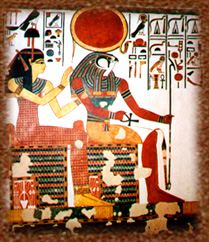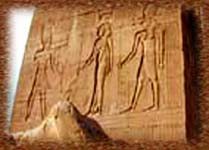| Development
of Ancient Egyptian Art |
Egyptian
Art
The
aesthetic qualities of ancient Egyptian art are greatly admired
in our modern day and age, however the concept of art for
art's sake was non-existent in ancient Egypt. Although the
Egyptians did aim for great aesthetic levels in their art,
they did not create masterpieces for the simple pleasure of
admiring them. Egyptian art was, for all intent and purposes,
a religious and funerary art that played a significant part
in the cult of the gods and the dead. The magnificent art
pieces displayed in museums across the world are now out of
their original context and, understandably, it is sometimes
difficult to understand their significance. Colourful paintings
and reliefs, which once decorated the walls of tombs of Pharaoh
and the royal family, wealthy officials, courtiers, and nobles,
ensured the survival of the deceased in the afterlife. Sculptures
could serve as a home for the " kÔ " of the deceased (his
spiritual essence) while others would be ex-voto and gifts
offered to a deity. Some statues were even the manifestation
of gods residing in a temple, where priests performed daily
rituals and saw to the well being of the god.
|
Hathor
and Re-Horakhty from the tomb of Nefertari from the
19th Dynasty found in Facsimile of Nefertari's tomb
paintings in the Harrer Collection, San Bernardino,
California
|

Credits: Caroline Rocheleau |
Although
the Egyptians expressed themselves and their culture in many
artistic ways, the present text deals solely with the so-called
"major arts" : sculpture, painting, and sculptured relief.
Architecture, which is also one of the major arts, will not
be discussed here since it is rather lengthy a topic. Painting
and sculpture are two artistic expressions with which all
are familiar, however, the principle of sculptured relief
might be foreign to many. Sculptured reliefs, in very simple
words, are basically drawings that have been carved on flat
surfaces, stone walls and slabs being the prominent surfaces.
Once the desired figure has been drawn on the wall, the artist
can remove a thickness of the flat surface around the figure,
giving the impression that the figure sticks out from the
wall. Such type of relief is known as "raised relief." On
the other hand, if the artist carves the contours of the figure
and the figure itself really deep into the wall, the illusion
of the figure being embedded in the wall is created. This
is called "sunk relief." Sunlight dance and play with the
carvings, thus creating shadows that give the reliefs a certain
fullness and roundness impossible with pictures simply drawn
on a wall. Such is the beauty of sculptured reliefs.
|
Sunk Relief from a temple at Denderah
from the Graeco-Roman Period found in Denderah
|

Credits: Egyptvoyager |
Development
of Ancient Egyptian Art
Ancient
Egyptian art, like any other artistic expression of a given
period, reflected the social and cultural milieu from which
it emerged. Additionally, the physical and geographical environment
played a major role in the initial development of what may
be define as typical Egyptian art.
A
quick glance at a geographical map of Egypt reveals a country
bordered by fantastic natural frontiers.
|

|
The
northern border was the Mediterranean Sea, a formidable body
of water, which only the most adventurous merchants would
dare cross. The Sahara Desert (also called the Western Desert)
separated Egypt from its western neighbour, Libya. Another
desert, the Eastern Desert, which the Egyptians believed was
filled with monsters, stretched between the Red Sea Coast
and the Nile Valley, creating the eastern border. South, the
Batn el-Haggar (the Belly of the Stones), a most desolate
and arid region between the Third and Second Cataracts of
the Nile River, in Nubia, was another excellent natural border.
In addition to the Batn el-Haggar, the numerous cataracts
on the river made sailing into Egypt from the south extremely
perilous.
Although
arid deserts, dangerous seas, and cataracts surrounded the
country, Egypt was nevertheless a very fertile and promising
land. The regular and predictable floods of the Nile River
left a thick black silt that fertilised the land, thus allowing
peasants and pastoralists to settle in the valley and prosper.
Moreover, within the boundaries of Egypt, the Nile is free
of cataracts and thus navigable. Egypt was truly the 'gift
of the Nile'. Such geographical isolation and luxurious environment
resulted in a self-reliant and self-sufficient civilisation.
The Egyptians were aware of the richness of their land and
its life-giving river, and they were intimately attached to
it. According to them, there was no place like home. Not surprisingly,
the recurrent motif in Predynastic art, as seen on decorated
ceramics, was a boat with many oars and a deck cabin. Additionally,
hunting and pastoral scenes as well as vegetal motifs displayed
the richness of the Egyptian fauna and flora.
However,
this does not imply that the ancient Egyptians were totally
devoid of foreign contact. On the contrary. Egypt maintained
commercial contacts with its neighbours, Mesopotamia among
others, and the influence of such contacts can be seen in
art of the Predynastic period. A typical Mesopotamian motif
borrowed by the Egyptians can been seen on wall paintings
and on artefacts, such as the ivory handle of the so-called
Gebel el-Arak knife (Louvre Museum, Paris): the man wrestling
two beasts. Although the Egyptians borrowed a few artistic
elements from their northeast neighbour, they had already
begun to culturally and artistically define themselves and
develop a style that could be identified as typically Egyptian.
Indeed, the artistic conventions adopted during the later
part of this early period were to regulate Egyptian art for
the next 3000 years.
Following
the unification of Upper and Lower Egypt, in spite of the
regular commercial ventures abroad, foreign motifs were almost
never used in the next three millennia of intense artistic
activity. Instead, internal politics, periods of economic
prosperity as well as social and religious values were to
influence art. Expectedly, the art of the Old Kingdom reflects
the economic prosperity of the country and the skill of the
artists trained in royal workshops while the crude sculptures
and paintings of the First Intermediate Period are the result
of a country stricken by famine and civil war, where untrained
artisans imitated to the best of their ability the art of
the previous epoch.
Yet,
the most incredible change of artistic values occurred during
a very prosperous age (end of the Eighteenth Dynasty, New
Kingdom), at the instigation of Pharaoh Akhenaton (Amenhotep
IV), the heretic king. Akhenaton favoured the cult of the
solar disk Aten above Amun, the national god, and all the
other deities of the Egyptian pantheon. Serious changes in
the artistic repertoire and Canon of human proportions thus
resulted from Akhenaton's reign and this religious revolution.
Egyptologists refer to this interlude as the Amarna period.
King
Tutankhamun, and the last pharaohs of the Eighteenth Dynasty,
who ruled after him, reinstated the traditional artistic norms
and former religious beliefs. Despite the Amarna interlude,
New Kingdom art equalled and, according to many, surpassed
in quality and beauty the masterpieces of the Old Kingdom.
The
Late Period, which is often considered a period of decline
because of the decentralisation of imperial power, competing
dynasties, and various invasions, nevertheless reveals that
many of the rulers kept the ancient traditions alive, inspired
by the glories of the past.
As
Alexander the Great conquered the Near East, a wave of Greek
influence followed him. Egypt, which had initially inspired
Greece (Hellas), was not immune to Greek (Hellene) influence.
Hellenisation of Egyptian art was more or less subtle, yet present.
Later Roman influence, however, was more than obvious.
(Caroline
Rocheleau)
|
|